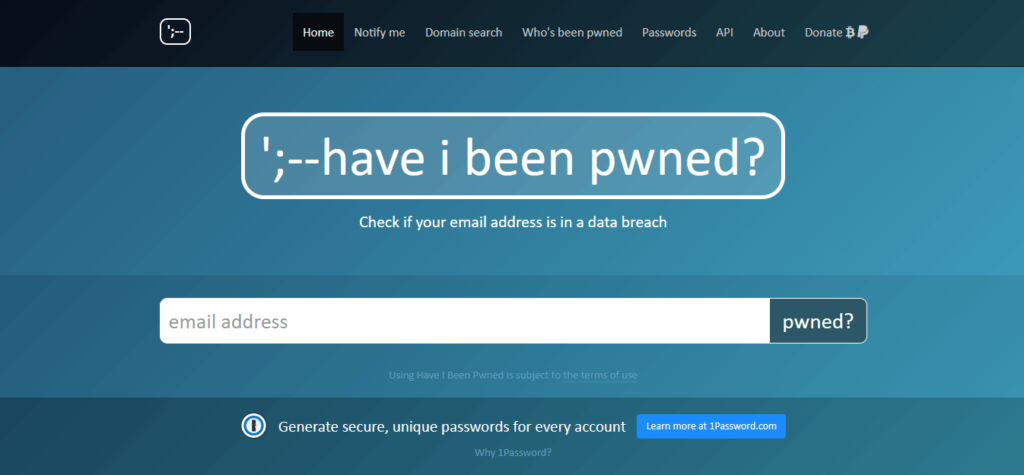How To Use Have I Been Pwned To See If Your Data And Passwords Were Stolen and were leaked on the internet. A guide to check latest data breaches and protect yourself and your accounts online.

Table of Contents
Introduction to Data Breaches and Data Leaks
In today’s digital landscape, the security of our personal information is more important than ever. With the increasing frequency and sophistication of cyberattacks, it is crucial to understand the impact of data breaches and the steps we can take to protect our digital identity.
A data breach occurs when unauthorized individuals gain access to sensitive information, such as personal data or financial details, without permission.
On the other hand, a data leak refers to the unintentional release of private information. Both data breaches and data leaks can have severe consequences, including identity theft, financial loss, and damage to one’s reputation.
Understanding the Impact of Data Breaches
The impact of a data breach can be far-reaching and devastating. Personal information, such as social security numbers, addresses, and credit card details, can be sold on the dark web, leading to identity theft and financial fraud.
Moreover, the leaked data may be used to launch targeted phishing attacks or gain unauthorized access to other accounts.
The aftermath of a data breach often involves lengthy legal battles, damaged reputations, and financial repercussions for both individuals and organizations.
It is essential to comprehend the gravity of these incidents and take proactive measures to safeguard our digital identity.
The Importance of Safeguarding Your Digital Identity

As individuals, we entrust our personal information to various online platforms and services. From social media accounts to online banking, our digital identities are scattered across the internet.
Consequently, it becomes crucial to protect our online presence from potential security breaches. Safeguarding our digital identity not only shields us from financial loss but also protects our reputation and personal relationships.
By taking proactive steps to secure our digital presence, we can minimize the risk of falling victim to cybercrime and maintain peace of mind.
Introducing ‘Have I Been Pwned’ – A Tool for Checking Data Breaches
In the battle against data breaches, ‘Have I Been Pwned’ is a valuable tool that can help individuals assess the security of their digital identity.
Created by security researcher Troy Hunt, ‘Have I Been Pwned’ allows users to check if their personal information has been compromised in past data breaches.
This free service has gained widespread recognition for its comprehensive database of breached accounts and its user-friendly interface.
By utilizing ‘Have I Been Pwned,’ users can take proactive steps to secure their digital identity and minimize the potential risks associated with data breaches.
How ‘Have I Been Pwned’ Works
‘Have I Been Pwned’ works by collecting and analyzing data from publicly disclosed data breaches. Whenever a breach occurs, the compromised data is often shared on the internet or sold on the dark web.
Troy Hunt’s service collects this data and indexes it, making it easily searchable for individuals concerned about their security.
Users can visit the ‘Have I Been Pwned’ website and enter their email address or username to check if their accounts have been compromised in any known data breaches.
The service also offers a feature called “Notify Me” where users can sign up to receive alerts if their email address appears in future breaches.
Benefits of Using ‘Have I Been Pwned’
Utilizing ‘Have I Been Pwned’ offers several benefits for individuals concerned about the security of their digital identity.
Firstly, ‘Have I been Pwned’ tool provides users with peace of mind by allowing them to check if their accounts have been compromised in past data breaches.
This knowledge empowers individuals to take appropriate action, such as changing passwords or enabling two-factor authentication, to safeguard their accounts. Secondly, ‘Have I Been Pwned’ helps users stay informed about potential risks and vulnerabilities.
By signing up for breach notifications, individuals can promptly respond to any new breaches that may affect them.
Lastly, the service encourages a proactive approach to security by raising awareness about the prevalence and impact of data breaches.
Types of Data Breaches Covered by ‘Have I Been Pwned’

‘Have I Been Pwned’ covers a wide range of data breaches, ensuring that users have access to comprehensive information about potential security risks.
The service includes breaches from various sectors, including social media platforms, online retailers, financial institutions, and government agencies.
By encompassing a diverse range of breaches, ‘Have I Been Pwned’ provides users with a holistic understanding of the potential vulnerabilities associated with their digital identity.
How to Use ‘Have I Been Pwned’ to Protect Your Data
Using ‘Have I Been Pwned’ is a straightforward process that can be completed in a few simple steps:
- Visit the ‘Have I Been Pwned’ website (https://haveibeenpwned.com/).
- Enter your email address or username in the search bar.
- Click on the “Pwned?” button to initiate the search.
- Review the results to see if your account has been compromised in any known data breaches.
- If your account has been breached, take immediate action by changing passwords and enabling additional security measures.
By regularly using ‘Have I Been Pwned’ to check the security of your accounts, you can stay proactive in protecting your digital identity and minimize the potential risks associated with data breaches.
Additional Steps to Safeguard Your Digital Identity

While ‘Have I Been Pwned’ is an invaluable tool, it is essential to adopt a multi-layered approach to safeguarding your digital identity. Here are some additional steps you can take:
- Use strong, unique passwords for each online account.
- Enable two factor authentication whenever possible.
- Regularly update your software and devices to ensure you have the latest security patches.
- Be cautious of phishing attempts and avoid clicking on suspicious links or downloading attachments from unknown sources.
- Monitor your financial statements and credit reports for any unauthorized activity.
- Educate yourself about cybersecurity best practices and stay informed about the latest threats and trends.
By combining the use of ‘Have I Been Pwned’ with these additional steps, you can significantly enhance the security of your digital identity and reduce the likelihood of falling victim to data breaches or other cyber threats. You can also use password manager which offers features such as resetting all of the passwords on platforms in case of any detected data breaches.
Also Read: Dashlane vs Bitwarden: Which password manager is right for you?
FAQ
Is the ‘Have I Been Pwned’ website safe?
Yes, the ‘Have I Been Pwned’ website is considered safe. It’s operated by a reputable security professional, Troy Hunt. The website doesn’t require you to enter sensitive information like passwords. You can check if your email or password has been compromised in data breaches without exposing your confidential details.
What does it mean if your email has been pwned?
If your email has been “pwned,” it means your email address has been involved in a data breach or security incident. Cybercriminals may have accessed your email address and other associated information, potentially putting your online accounts and privacy at risk. It’s crucial to take action, such as changing passwords and enabling two-factor authentication, to secure your accounts.
Can you check if your password has been leaked?
Yes, you can check if your password has been leaked using the ‘Have I Been Pwned’ website. They offer a secure service that lets you enter your password (or a portion of it) to see if it’s been exposed in data breaches. This can help you identify compromised passwords and change them promptly for improved security.
Why am I in a data breach for a site I never signed up for?
Even if you’ve never signed up for a specific website, your information can still end up in data breaches due to various reasons. One common scenario is when a service you’ve used shares data with other sites or third parties. Additionally, attackers might obtain your information from breaches on other websites and attempt to use it on sites you’ve never visited.
How do you check if a website is safe without visiting it?
You can check if a website is safe without visiting it by using online tools such as website reputation services and antivirus software. These tools analyze the website’s reputation, security certificates, and potential malware presence. Additionally, you can look for “https://” in the URL, a padlock icon, and verify the website’s domain authenticity before clicking any links.
How do I know if a website address is safe?
To ensure the safety of a website address, there are a few essential steps you can take. Firstly, check if the website’s address begins with “https://”. This indicates a secure connection, providing an extra layer of protection for your data. Secondly, look for a padlock icon in the address bar. This icon signifies that the communication between your browser and the website is encrypted, guarding your information from potential threats. Moreover, it’s vital to verify the authenticity of the website’s domain. Keep an eye out for any suspicious typos, unusual characters, or slight variations in the URL that might indicate a phishing attempt. Lastly, you can leverage online tools like website reputation services or antivirus software to assess the safety of the website. By combining these precautions, you can make informed decisions about whether a website is safe to visit and interact with, minimizing the risk of encountering malicious or harmful content.
Conclusion and the Importance of Staying Vigilant Against Data Breaches
In conclusion, data breaches and data leaks pose significant risks to our digital identity and personal security.
It is crucial to understand the impact of these incidents and take proactive measures to safeguard our information.
‘Have I Been Pwned’ is a powerful tool that can help individuals assess the security of their accounts and take appropriate action to protect their digital identity.
By using ‘Have I Been Pwned’ in conjunction with other security best practices, we can fortify our digital presence and minimize the potential risks associated with data breaches.
Remember, staying vigilant and proactive is key to defending your digital identity in today’s interconnected world.